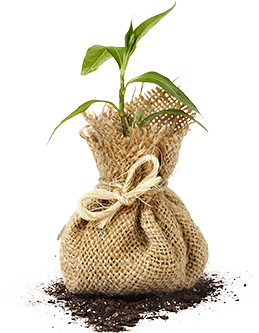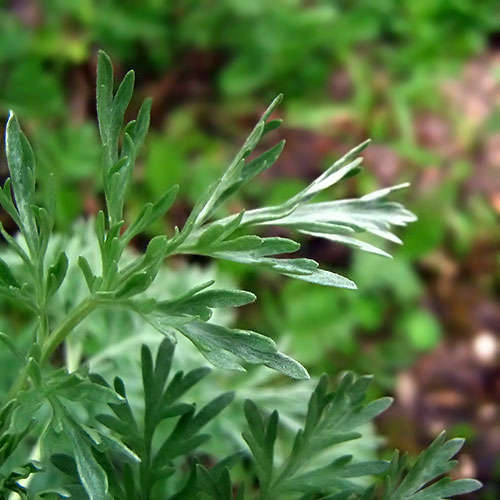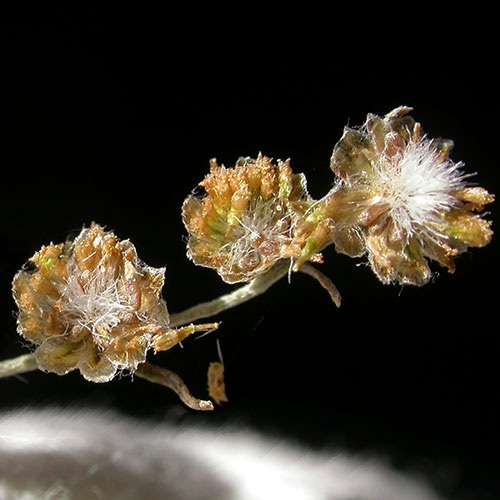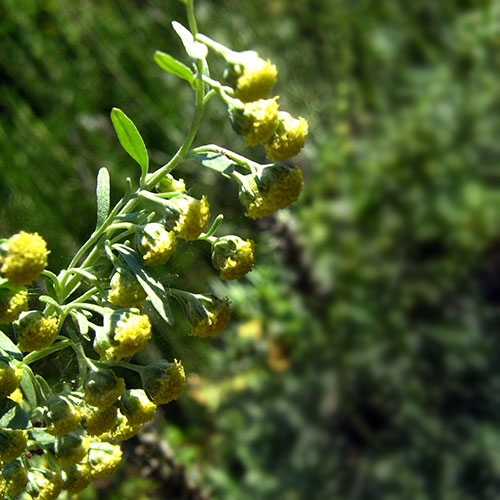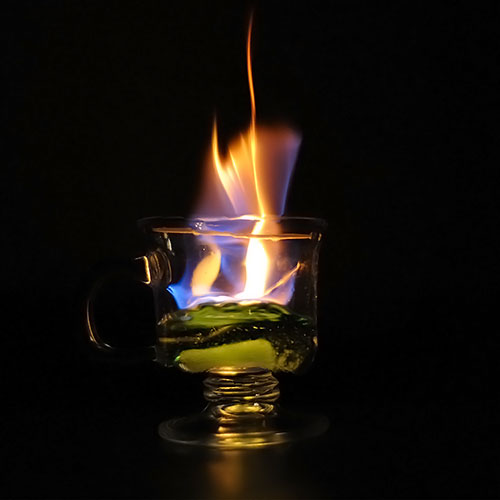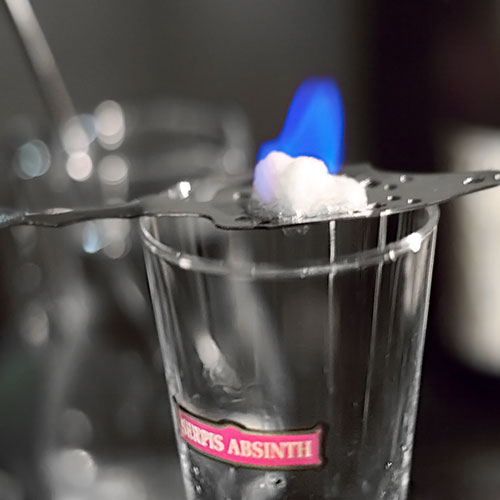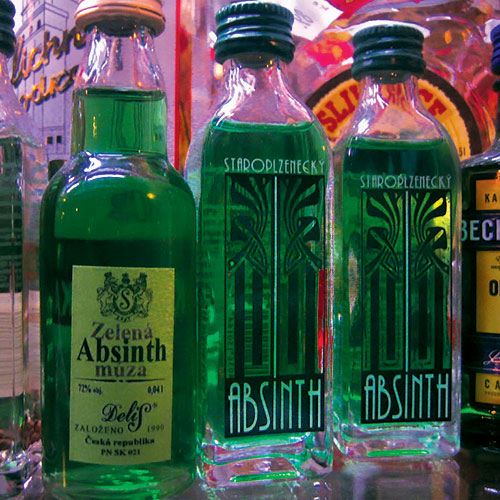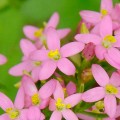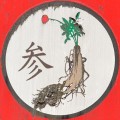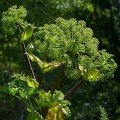The wormwood is known from the time of Hippocrates and is considered one of the most fragrant plants despite its bitter taste. In Ancient Greece it was called Artemisia, possibly in honor of the goddess Artemis and used in cases of amenorrhea. They thought that strengthens the memory and logic, helps in muscles aches, joints and connective tissues, strengthens the vision, deeper sleep. Because of the last property in the villages fill the pillows with Absinthe. In times of epidemics cholera and plague kremagan plant at residences and smoked places burning shoots Wormwood. Dioscorides writes for the Absinthe "…When the ink is mixed with egchyma wormwood mice without touching the scrolls»
Other folks like the Arabs, Egyptians, the Celts used the Absinthe as orexiogono. apodwsane during the middle ages several "magical" properties in Absinthe and believed that its existence in a home guard of evil spirits.
The herb Mugwort – Artemisia absinthium
The Wormwood [lats. Artemisia absinthium], known as Absinthe, agriapsithia, infidelity, pelino and abrobotano belongs to the genus Artemisia as a kind of apsinthi. It is a herbaceous perennial plant that xirofyto the amount fluctuates depending on the subspecies from 20 cm. up to 1, 20 m. Thrives in temperate and warm countries as native in barren and rocky places.
Characterised by upright stem with alternating European oak, Instead, slightly scented, leaves, silver-green colour, covered by white hairs to reduce transpiration. The flowers are small, kitrinoprasinoy color and form small discoid heads (anthidia), which in turn organized into inflorescence fobi (botrywdis inflorescence). From this complex arrangement of flowers took the family name of the compound. Bloom from June to September.[source: Wikipedia]
Their juices have a bitter taste and this is the main plant essential oil of the plant, essential oil Green, the apsinthi.
The wild Absinthe
Herbal medicine used leaves, the flowering tops of the native argia Absinthe. Collected summer shoots and roots in the fall.
Wormwood herb ingredients
The wild Absinthe is rich in volatile oil that contains seskiterpenikes lactones (artavisini, anapsinthini), thyioni, lenes, Flavonoids, phenolic acids, Lignans. The use of essential oil of Wormwood like aromatic was abolished at the beginning of the 20th century, When it was discovered that the thyϊoni component (Thujone) containing excessive doses causes damage to the nervous system and hallucinations.
Properties of Wormwood and alternative treatments
It is a stimulant of the digestive, i.e. extremely useful drug for those who have poor digestion. Increases the acidity of the stomach and the production of bile and improves digestion and absorption of nutrients, helping other diseases
Generally, plant, in moderate doses, irritates the stomach, increases appetite, facilitate digestion, accelerate blood circulation, causes secretions, contributes to weight loss and digests fats. In therapeutic, grains used Wormwood. Helps in digestion and weight loss. (melts fats). Has a beneficial effect in diabetics and helps fight rheumatism. Can be used to combat anemia, as antipyretic, while it has diuretic properties. Outwardly, can be used as an antiseptic.
Other uses of wormwood (absinthe drink)
The fresh or dried stems repel insects and mice.
The dried leaves when fitted to repel clothes moths. Discourage slugs and insects and it is currently used in the manufacture of insect.
DOSAGE Infusion with 1-2 teaspoons of dried herb in a cup of boiling water and leave for 10-15 minutes.
Internally, used in powder form 0,5-2 g. as stomach and 4-10 g. as vermicide.
In cases of epilepsy and convulsions used dust from the crushed roots of wormwood, from 1- 3 teaspoons of coffee per day, alone or with a little sugar.
Precautions and side effects
Take in small doses, and not more than 2 weeks each time. Do not take during pregnancy.
Always use herbs under the supervision of an experienced and especially when you get along any medications or herbs.
Must be careful and use of infusion of wormwood because it can cause various disorders such as headaches, convulsions, miscarriage, cardiac abnormalities to death.
The history of forbidden drink "absinthe"
Absinthe (absinthe drink) accused of causing addiction, hallucinations and schizophrenia, loved for its emerald color, dizziness and inspiration that gave, birth myths, became a legend, refused and returned dynamically .... Perhaps the only drink with such aura of mystery around his name, Absinthe became, the bicentennial history, enthusiastic fans and sworn enemies.
For the method of manufacture and the side absinthe, until the official country of production, Serving the way and ban, there are many different views.
The only point on which everyone agrees, is the current European Union legislation, which entered into force in 1988 and dictates that "absinthe can no longer be manufactured and sold legally, provided they do not contain more than 10 mg thyioni (thujone)». Wherein thyioni-or otherwise-thougioni see the toxicant to the basic preparation of absinthe herb, of wormwood, the ban which was necessary.
Father of modern absinthe recipe is by Dr. Pierre Ordinaire, who manufactures first drink with current form 1792 στη Val de Travers της Ελβετίας, calls this "green fairy" and sells claiming to cure everything, from headaches to epilepsy and kidney stone. Shortly later, the Major Dubied sees the potential of "green fairy" not as drug, but as an aperitif, buys the patent and started production. It 1805, the groom, Henri-Louis Pernod will establish the legendary Pernod Fils in Pontarlier of France, which profits from the production of absinthe will reach the limits of myth.
French soldiers consume large quantities of absinthe in 1840, during the war with Algeria, because it seems to protect them from malaria-making them, parallel, to forget the hardships and the overall state. Some years later, absinthe will go through the battlefields in the cafes and cabarets of Paris, where you will find great appeal in artistic circles. An evening of 1889 the Toulouse Lautrec serves a cocktail based absinthe its frequenters Moulin Rouge and the Green Fairy officially acquires her passport for the circles of the intelligentsia. Baudelaire, Verlen, Rimbaud, Zola, Picasso, Hemingway and countless others swear hereafter in his name and the term "apsentismos" written in green letters-in-history.
The beginning of the end came when, the end of the 19th century, Arles in the South of France Vincent van Gogh cut off his ear, after a particularly intense fight with roommate, Gauguin Paul. Act which was attributed to excessive consumption of absinthe and, along with various other side effects that conservative circles claiming that causes the green poison "correct and respectable in other people, which transforms into monsters', eventually led to its closure in almost all European countries except the Czech, Spain and Portugal.
Ban which was attributed, later, the surge in sales of the Green Fairy soaring, and to complaints by producers of other alcoholic, between them and the winemakers of France, who saw their revenues shrink. Almost a century later, The ban was lifted by the Law of the European Union, and today continues to apply in some countries, as the U.S. and some provinces of Canada.
What is absinthe
Absinthe is high alcoholic distillate with wormwood ( absinthe). For the preparation used, according to the traditional recipe, three herbs: absinthe, anise and fennel. After distillation, the green color is added either naturally, infusing other herbs in the mixture, or pigments, content and the alcohol-in at this stage reaches 82% - tempered by adding water. The end result is a green alcoholic, that yellowing with age, the content of which alcohol may range from 45% until 74% and which, explains the etymology, undrinkable plain-any attempt, as earnest though it, requires the addition of water and sugar.
Clarifying three (interesting!) myths about absinthe
1In the movie Moulin Rouge, The Toulouse-Lautrec and his friends wetting a spoonful of sugar with absinthe, of firing, disintegrating in the drink, extinguishing it with water and clink their glasses.
This way of serving, γνωστός ως bohemian style, introduced at the bar in Prague on early 1990.
According to the traditional recipe of the early 19th century, authentic absinthe-spoon of this by-holes placed on a glass filled in 1/3 with absinthe. After putting in a spoon of sugar cubes, slowly pour ice water, until the sugar melts and glass filled. The dissolved sugar and water muddied absinthe, which obtains in this way the right flavor.
2It 1864, ο Dr. Valentin Magnan help in the war against absinthe with experiments conducted in guinea pigs, and which concluded that thyioni contained in absinthe causes convulsions and other side effects, making this drink more dangerous than other spirits. Despite being accused of causing hallucinations, addiction, schizophrenia and other side effects that led to its closure, The association of these symptoms with thyioni never proven scientifically. The green fairy who saw the Lautrec and his friends, and tulips at the feet of Oscar Wilde attributed, finally, the high content of absinthe alcohol-which led to the lifting of the ban, to the aforementioned condition of restricted content thyioni, which may not be, finally, psychedelical, be, yet, in large quantities, toxic.
3In demonization of absinthe came, it 1986, To add another urban legend. According to the Book of Revelation, "During the third call, fell from heaven a great star like candle in 1/3 the rivers and fountains of waters. The name of the star is wormwood. A third of the waters became wormwood, and many men died from the water because it was bitter ». In Ukrainian, Chernobyl called a plant similar to wormwood, the Latin name of which is Artemisia vulgaris-while the wormwood Artemisia absinthium. Detail skipped when the New York Times published a relevant article after the nuclear accident, in which a Russian writer, whose name was not released, was allegedly says Chernobyl in Ukrainian means wormwood, giving way to the creation of the myth.
Market supply and absinthe trading
A widespread-until recently-marketing trick like absinthe be either illegal or scarce within European borders. Neither shall not apply. Absinthe bit overpriced, but entirely legitimate-you will find many updates cellars, online shops and many bars in Athens and the province – most of which I use mainly for cocktails, after orders are rather limited.
One that is worth trying is the shot of B55-B52 but with absinthe. For best price, contact-if you travel- in duty free shops of countries of Eastern Europe. Not, will stop you at the border-reaches the amount to justify the somewhat vague term "personal use".
Where to find to buy absinthe?
A cursory search on the green bar (bottom of the page) for absinthe drink apodiknyei that you can obtain Internet mail by courier from England, price starts from 3,99 pounds-approximately 5 €. The Absinthe that sold freely de, as you will see, has the original composition, including the controversial ingredient “thyioni”
Guests currently searching, are reading here for: Wormwood herb, Wormwood herb properties, herbs for fat breakdown, Wormwood herb parenergeies, Wormwood herb plant picture, αψεντι παρενεργειες, kallwpistika insect repellent, botano wormwood herb, Wormwood herb botano properties, Wild psithia.







